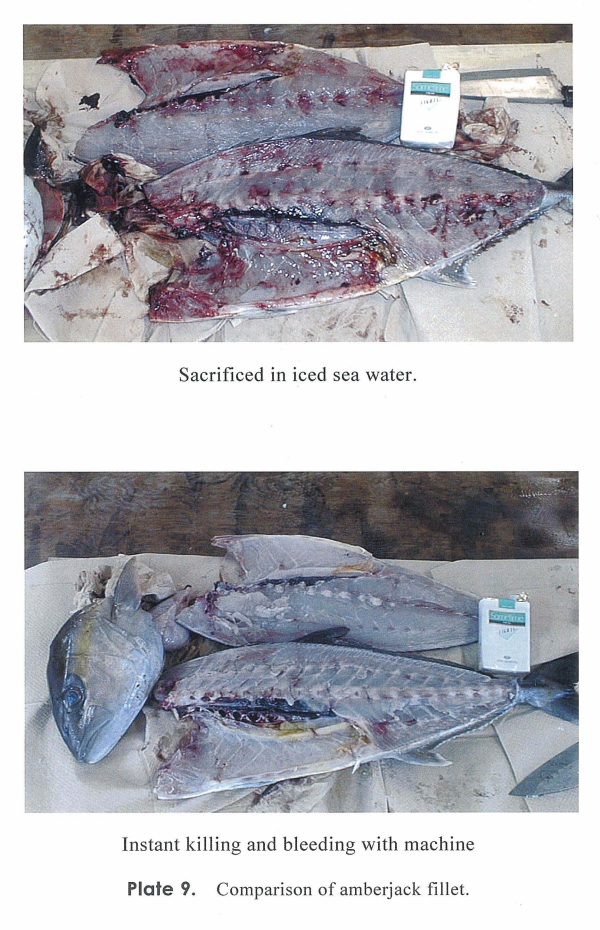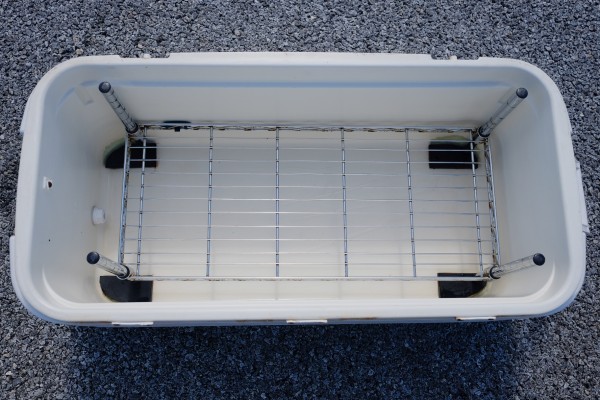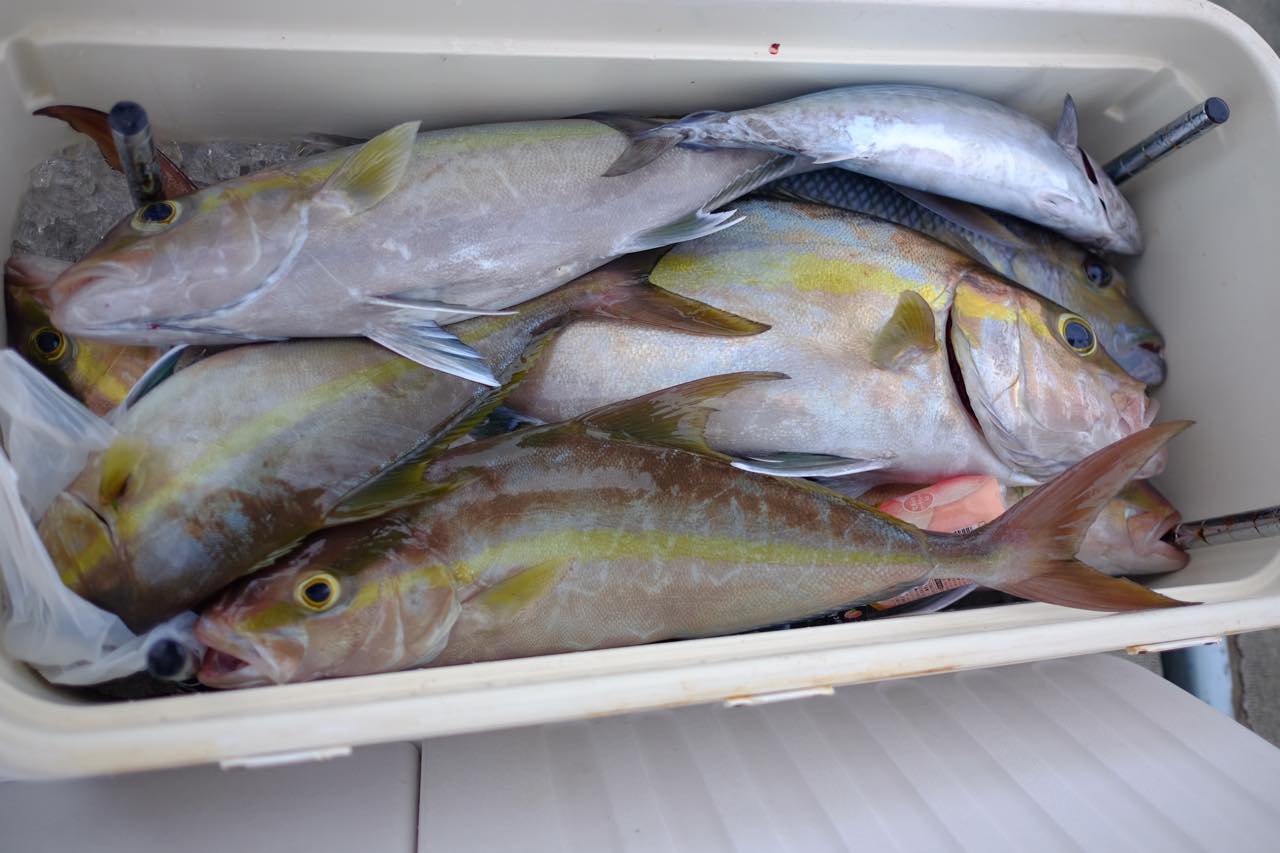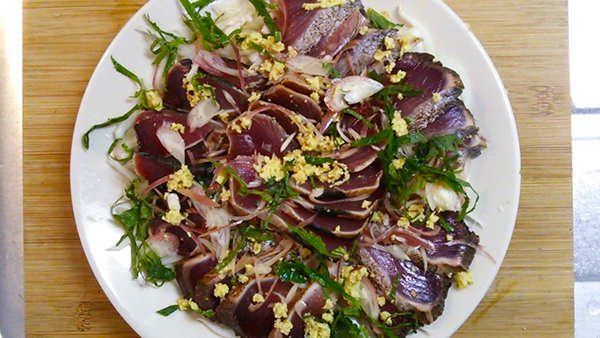How to keep your catch cooled
Fish meat loses its quality much more and faster than other animal meat. And freezing does far more damage to fish meant than to animal meat.
This facts involve a great impact on commercial fishing. Properly treated fish can be valued very highly as live fish, especially in a fish eating country like Japan. That is why several scientific studies have been done on how to keep fish fresh for the longest period of time.
All the studies show that ike-jime is effective in lengthening tasty period by 3 or 4 times at least. That’s several days of expansion, depending on the fish species. It doesn’t take a sushi chef to know that is a big difference.
Comparison between closing in iced sea water and Ike-Jime closing
Study by Agriculture, Forestry and Fisheries Research Council Secretariat Japan

Cooling Rigor
Cooling rigor is the other thing we want to look at. All the studies show the temperature to keep the closed fish also has a big impact on tasty period.
I’d like to call it “tasty period” instead of “fressness” by the way. There seems to be a common misunderstanding on freshness, I think.
Everyone thinks favorably of “fresh fish”. But who would think the fish is good when your chef announces that the fish has been dead for 3 days? But if properly treated and aged, the fish can be at its tastiest moment in Day 3. A 200kg tuna can be at its tastiest moment when it’s been dead for 2 weeks! But who would call that “a fresh fish”? On the other hand, a 200kg tuna on the day of catch is certainly fresh, but it just feels tasteless and gummy.
Anyway, back to cooling rigor. All the studies show that if you put the fish into 0C degree, you are risking to bring on cooling rigor to the fish. Cooling rigor basically does the same thing as rigor mortis. It speeds up ATP breakdown process, shortening tasty period by far.
Fish is best to be kept in moderate cooling at 5C to 10C until rigor mortis is complete.
Ike-jime slows down rigor mortis. Without Ike-jime, rigor mortis may complete within 6 to 8 hours. But with Ike-jime and moderate cooling, rigor mortis gradually completes within 24 hours to 72 hours after closing. Complete rigor mortis means all ATP has been broken down to IMP, and all other Umami amino acids (breakdown of proteins) are still more to come. Fish is at its tastiest when the rigor mortis completes. It has both fresh texture, beautiful translucent looking and enhanced Umami by IMP and other increasing amino acids. Then it will enter different kind of tasty period, as texture will soften, Umami will be richer, the kind of tastiness of jamon serrano. Eventually tasty duration fades, more anmonia will be produced and fish is on its way to decomposition. Ike-Jime makes this process slow and lengthens tasty period. Moderate cooling helps it. But if you do 0C cooling, it may cancel that Ike-jime effect. That’s what studies show.

So dumping your catch into an ice bucket is not a good thing to do.
It’s OK for maybe 30 minutes (It depends on the size of the fish) just to bring down the internal temperature to slow down bacteria and enzyme. (It needs to be iced ocean water of course.) But then you should move it to moderate cooling zone.
After rigor mortis is complete in moderate cooling zone, it’s believed better to save it in cooler temperature, close to 0C, and it makes tasty period even longer. But this part is not confirmed by a study probably because the commercial fish should be in the hands of restaurants by this time. The purpose of all the studies is for enhancing commercial fishing industry, not for restaurant business.
How to store your catch
On the boat
After Ike-jime, place fish on the ice, not into the ice. And not into the iced ocean water.
I have checked the temperature in your cooler box with the ice full. It is an Igloo Classic cooler which holds ice for 5 days. It was 5C over the ice, 8C to 10C just below the lid. It is pretty ideal for moderate cooling.
Back home
I clean my catch usually the next day. I would do it in the evening of the day of fishing if possible, but usually I’m too tired. There’s no need to rush here.
I scale, cut the head off, take guts out, and brush off the major blood vessel on the belly side of the spine. If I want to keep the head for cooking, I take the gills off, and brush off all the blood chunks around the brain too.
The least possible cuts
It’s best to store fish with the least possible exposure to the air. Exposed surface would risk oxidization and bacteria infection. I don’t fillet it at this point. And I don’t skin it either.
You should keep the head on if possible. Just make as little cuts as possible to get guts and gills out and brush off blood. Keep the rest meat shielded in its body.
Store for aging
I use my cooler to store fish for aging. I don’t have big enough fridge to store my fish. My wife is happy this way too.
I wrap fish with paper towel because there will be drips from fish and I don’t want fish to sit in the drips. I change this paper towel everyday.
I place a foam plastic sheet over ice and put fish on top of it. You can isolate fish from ice to prevent cooling rigor. If you don’t have a foam plastic, I think it’s OK to just put wrapped fish in a plastic bag and place it on ice. Fish skin is a natural temperature separator, I assume. Just not into ice.

This is my cooler. I put in a shelf to elevate fish to prevent soaking in the melted water. I still need to drain excess water from time to time, though.
Black things are hard rubbers I have adhered on the bottom. All the ice and fish concentrated in the tiny legs of the shelf can be too much for the bottom plastic.
I hope you find this article informative and helpful to you!
If you like the post, please click on one of my sponsor banners and see their commercial. (You don’t have to buy anything!) It helps me to finance my site. Thank you very much.
Related Posts
6 Comments
Leave a Reply to Ben Ong Cancel reply
Categories
- 1. SPJ (57)
- 1-1. Principles (9)
- 1-2. Techniques (11)
- 1-3. Setup (17)
- 1-4. FAQ (19)
- 1-5. Tackles (3)
- 1-6. Video Gallery (2)
- 2. Other Offshore Games (5)
- 3. Fishing Report (105)
- 3-1. Totos (25)
- 3-2. Readers (72)
- 4. Fish Cooking (19)
- 4-1. Iki-Jime (3)
- 4-2. The Art of Sashimi (5)
- 4-3. Recipe (7)
- 4-4. Seasoning (3)
- 5. Fishing Charter (6)
- Fish (12)





Great information, thanks so much
Great website and YouTube channel.
Thank you for sharing your knowledge. Information on ikejime and fish preservation techniques is scarce. You are doing a service to anglers everywhere.
Best Regards,
A fellow angler from Texas
Thank you Ben for your compliments. I’m glad to know that there are anglers like yourself who wants to treat your catch nicely.
Hello these articles are very interesting and tech how to respect fish. I like the way you treat our passion, Fishing. I’m in France if I could and knew how I’ll do orders. Wish you the Best.
Hi Patrick.
Yes, it’s respect indeed. I’m glad you pointed that out.
We will live on with what we eat. The fish we kill will become a part of us and we go on with them. Treating your fish nicely means treating yourself nicely.